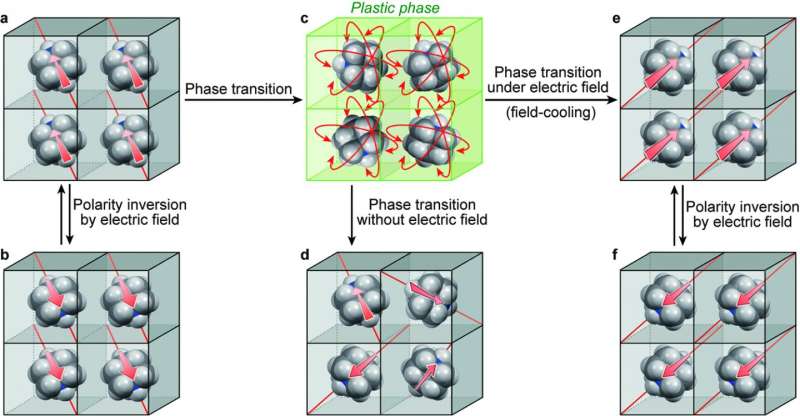August 2, 2016 report
Tunable and mechanically robust ferroelectric ionic plastic crystals

(Phys.org)—New research by a group from Hokkaido University in Japan has shown that the plastic ionic crystal, quinuclidinium perrhenate, has ferroelectric properties and can serve as a model for finding new plastic ionic crystals that demonstrate ferroelectricity with directional tunability. Their work appears in Nature Chemistry.
Ferroelectric materials are spontaneously polarizable. The polarity of ferroelectric materials can be reversed by placing the material in an inverted external electric field. This ability to switch the material's polarity has been used for several applications including memory devices. Organic ferroelectric materials, in particular, are of interest because they are non-toxic and easier to make than their inorganic counterparts.
However, there are several obstacles to practical application of organic ferroelectric crystals. Each crystal in a substance can be polarized only along its polarization axis, which is dependent on the molecular dipole orientation within the crystal. For effective performance of ferroelectric materials, the polarization axis of the individual crystals in a substance must align in a particular direction. In contrast to the high symmetry seen in inorganic ferroelectrics, the low symmetry in organic crystals has made it difficult to fabricate ferroelectric materials with their polarization axes aligned in the desired direction.
Plastic crystals tend to be waxy. They are an intermediate state (mesophase) between the liquid and solid phases, so they have more molecular degrees of freedom than ordinary crystals. Molecules that exhibit a plastic crystal phase tend to have a globular structure. Plastic crystals have a high degree of crystal symmetry resulting from isotropic molecular rotation, and undergo several solid-to-solid phase transitions upon cooling. Those solid-to-solid transitions often exhibit a change from a high degree of symmetry to a lower degree of symmetry of the crystal. Given these properties, quinuclidinium perrhenate, was chosen as a model plastic crystal system to investigate whether it has ferroelectric properties.
The quinuclidinium cation has spherical symmetry and a dipole moment while the perrhenate anion has tetrahedral symmetry and is nonpolar. Crystals of quinuclidinium perrhenate were studied using differential scanning calorimetry, which showed three different solid phases that the authors describe as low-, intermediate-, and high-temperature phases. The low- and intermediate-temperature phases had polar geometries (described as non-centrosymmetric) while the high-temperature phase (a plastic crystal phase) displayed a non-polar geometry. This correlates well with the characteristics necessary for a ferroelectric transition in which the solid state has a dipole moment below the Curie temperature but is non-polar above the Curie temperature.

Additional studies looked at the crystal structures in different phases. This confirmed that the low-, intermediate-, and high-temperature phases have different symmetric point groups, namely C2v to C3v to Oh, respectively.
The crystals were then tested for ferroelectricity. As expected from the crystal symmetry, polarization-electric field plots in the intermediate-temperature phase demonstrated the characteristic hysteresis loop for ferroelectric materials. It displayed a switchable dipole moment that did not evidence deterioration after 105 switching cycles.
Two aspects of these crystals that are helpful for real-world applications are the ability to change the direction of the original crystal's orientation and mechanical deformability. The original direction of the dipole moment can be re-oriented three-dimensionally by applying an electric field to the material while it undergoes a solid-to-solid phase change, owing to the high symmetry in the plastic crystal phase. The other helpful feature of these crystals is that the high-temperature phase can withstand mechanical deformity under pressure as evidenced from scanning electron microscopy studies.
These two features are particularly helpful for potential real-world applications because the crystals can be flexibly molded under high temperature, and then the direction of the dipole moment can be tuned by lowering the temperature and applying an electric field. The authors point out that this could be particularly useful for making solid thin films for flexible electronic devices.
More information: Jun Harada et al. Directionally tunable and mechanically deformable ferroelectric crystals from rotating polar globular ionic molecules, Nature Chemistry (2016). DOI: 10.1038/nchem.2567
Abstract
Ferroelectrics are used in a wide range of applications, including memory elements, capacitors and sensors. Recently, molecular ferroelectric crystals have attracted interest as viable alternatives to conventional ceramic ferroelectrics because of their solution processability and lack of toxicity. Here we show that a class of molecular compounds—known as plastic crystals—can exhibit ferroelectricity if the constituents are judiciously chosen from polar ionic molecules. The intrinsic features of plastic crystals, for example, the rotational motion of molecules and phase transitions with lattice-symmetry changes, provide the crystals with unique ferroelectric properties relative to those of conventional molecular crystals. This allows a flexible alteration of the polarization axis direction in a grown crystal by applying an electric field. Owing to the tunable nature of the crystal orientation, together with mechanical deformability, this type of molecular crystal represents an attractive functional material that could find use in a diverse range of applications.
Journal information: Nature Chemistry
© 2016 Phys.org


















